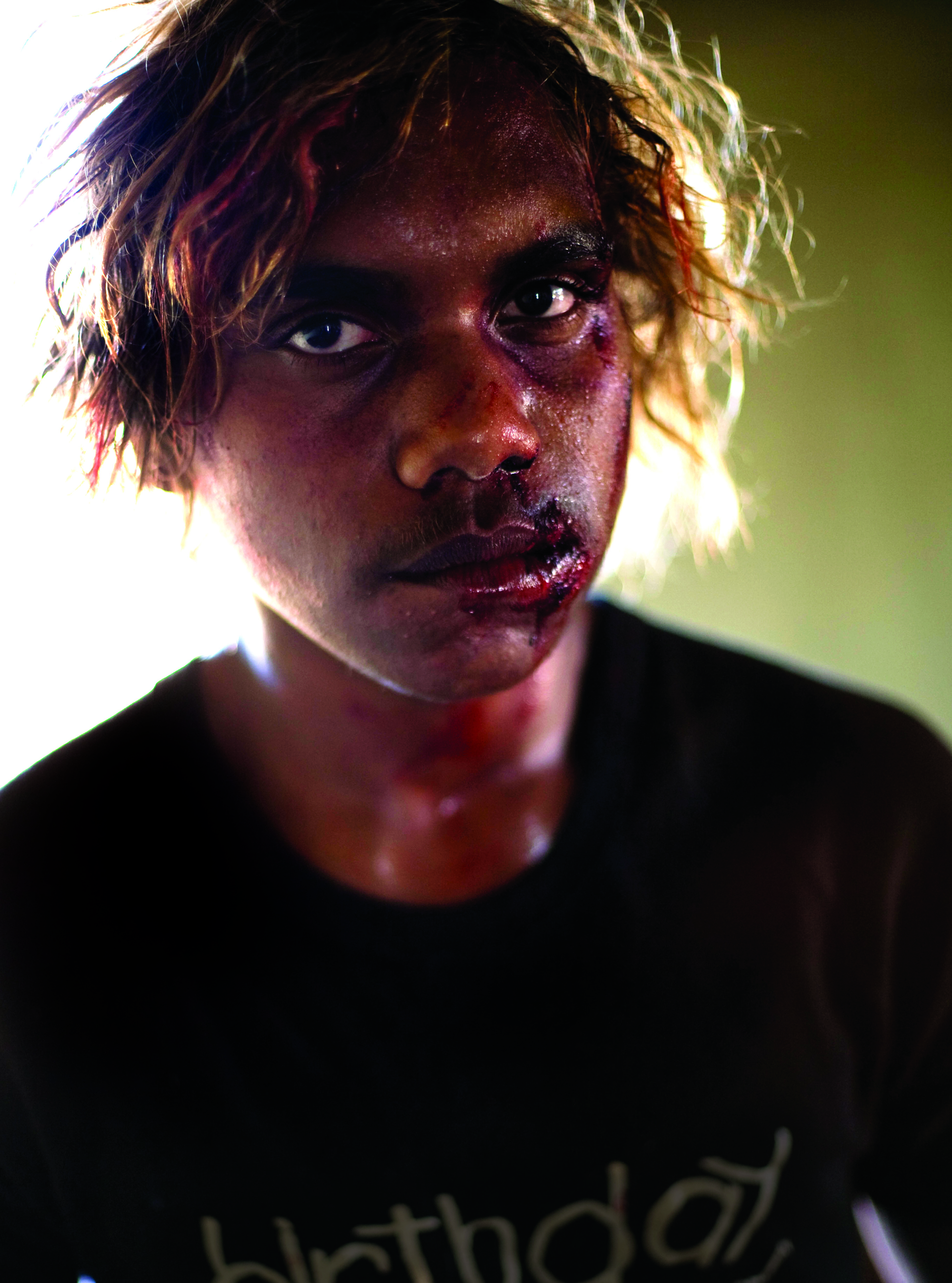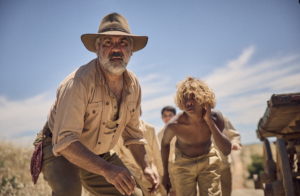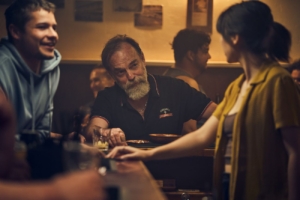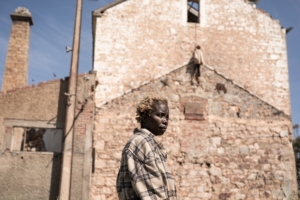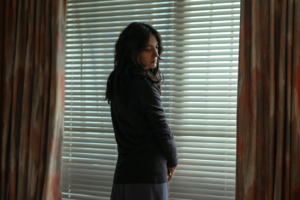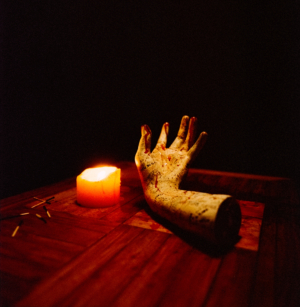He’s a quiet guy with a lot to say. From the care he puts into his statements, one gets the impression that he’s aware of his cultural significance, and of the need to say things right. Like his film, Samson and Delilah (2009), he exudes an unmistakable seriousness, a shameless belief in real love for real people, giving his ideas and actions the quality of truth. Meet the new hope of Australian cinema, Warwick Thornton.
Thornton and producer Kath Shelper discuss casting their unknown teenage leads, filming in Central Australia and what role the film should or shouldn’t play in the ongoing debate about the welfare of Aboriginal Australians.
TOM REDWOOD: Warwick, you’re about to become a lot more well known in this country than you have been so far. So tell us a bit about your life, where you grew up, what your childhood was like …
WARWICK THORNTON: I’m Alice Springs born and bred. I grew up ninety per cent of my life in Alice Springs. As a child I spent a couple of years living out on a community called Santa Teresa. All my family are there. My family are a tribe called Katej. Our area is about 200 kilometres north of Alice Springs. So Alice Springs is not my country (but, you know, same mob, different language group). I went away to high school in Western Australia, but I didn’t finish Year 8. I didn’t really like school. I didn’t like teachers.
So from there I went back to Alice Springs and became a DJ for CAAMA Radio in Alice Springs [the Central Australian Aboriginal Media Association]. This was in the mid 1980s, and at that time they started up a video unit to train Indigenous people in video making. So in 1987 I started a traineeship through CAAMA as video trainee/cinematographer. I did three years training there, but we weren’t really training. From day one we were shooting stuff, making films. And then, for about five or six years I shot documentaries, corporates and the occasional ad for CAAMA and Imparja TV.
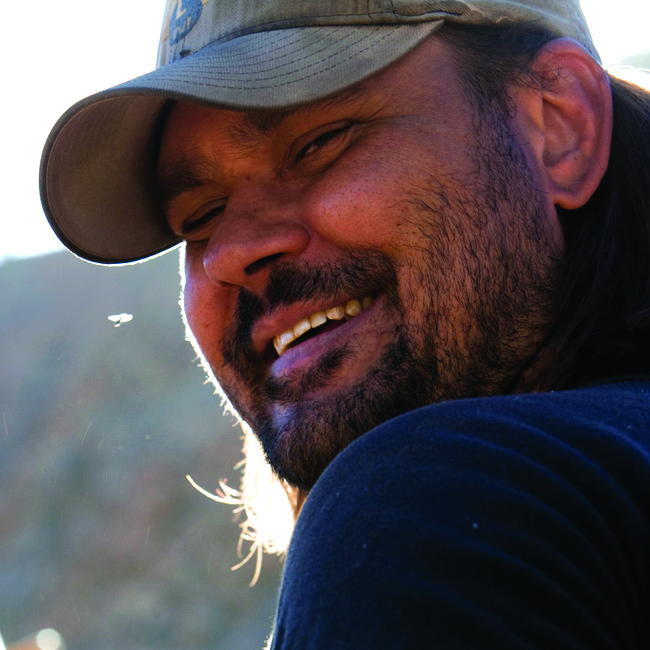
From there I applied for AFTRS [Australian Film Television and Radio School] in Sydney, and got in, and spent three years there doing a Bachelor of Arts in cinematography. After that I spent four or five years hanging around Sydney as a cinematographer. I shot a film there called Radiance [1998], directed by Rachel Perkins. But I got a bit sick of Sydney and the lifestyle there so I decided to go back to Alice Springs to sit down with my partner Beck [Cole, also a filmmaker] and buy a house and have kids and write some films. We started making short films like Mimi [2002] and Green Bush [2005] and Nana [2007]. And that brings us up to where we are now, with Samson and Delilah.
Kath, how did you come to work with Warwick as producer?
KATH SHELPER: I was the supervising producer of the series of short films that Mimi and Flat [Beck Cole, 2002] were part of, the series funded by the Indigenous Branch of the AFC [Australian Film Commission, now part of Screen Australia]. So I met Warwick then. But my role was supervisory. I was not his producer as such. I had been doing a lot with the Indigenous Branch of the AFC, like setting up workshops with [Indigenous Branch manager] Sally Riley. I helped organise the workshop that Green Bush was a part of. I got to read the script and I really loved it. Beck’s film Plains Empty [2005] was part of the same series, and she had asked me to produce that. And so one day in calling Beck to organise for her film I spoke to Warwick and he asked me, ‘Oh, do you wanna produce my film?’ And I said, ‘Yes!’ So I just happened to call at the week he needed a producer.
How long has Samson and Delilah been in preparation?
WT: I’ve been thinking about the film in the back of my head for a really long time. That’s the way I like to work. I don’t actually like the physical process of writing. I find it really painful. So before I write a film, I make sure I know exactly everything that happens (where it begins, who the characters are, where they go, where they finish, the style, the form, etc.). Everything I try to do in the back of my head before I go anywhere near a pen and paper. So I thought about this film for about two years. And then, when I was ready, it basically took about four days to actually write it, just to spit it all out.

And how long was that original script?
WT: About forty pages.
And was that script honed down over the shooting?
KS: No, it was honed up. The eventual script was about seventy pages, with some judicious spacing here and there. Warwick doesn’t re-write. The original forty pages are what you see on screen, plus some extra scenes and ideas added in on top. The original script was written at the end of 2005, around the time of Green Bush. And then he just put it aside and didn’t do anything with it for ages.
WT: It was kind of like, the film, I had to just get it out of the way. We weren’t sure what we were going to do with it. But I had to clear my head of that one because we got funding to write another one.
KS: And then Warwick kept thinking about it all the time, and every now and then he’d pull it out and add a scene in, and add a little detail in here and there.
So how much room was there for improvising during the actual shooting?
WT: None. There’s no dialogue, or not much anyway. So every single bloody scene, every look, every nuance, where they sat, the reason they stood up, whether they walked left or right, everything was really important because it was all a part of storytelling. So we had to seriously stick to the script. And we had to shoot it in sequence too, because of the haircutting. We weren’t jumping all over the shop because we weren’t allowed to. The script dictated all of that. A couple of times we had a free afternoon and we tried a new idea for a scene. But for the most part there were no improvisations.
And how many days shooting?
WT: Six weeks in all, at about a five-day week. We decided on a five-day week purely because it’s really good to give a crew two days off, especially when they’re in Alice Springs and they’re working incredibly hard and it’s really hot. And also for Rowan and Marissa [the leads], they’re first-time actors, they’re fourteen years of age, we needed to give them time to relax.
KS: And not to mention Warwick, who shot the film as well as directing it. And it’s all hand-held camerawork, so it was physically and mentally really taxing for him. But in the end we actually shot less than thirty days because we worked so quickly The kids and the crew were so fantastic we found ourselves moving the shooting schedule forward and found ourselves having days off.
Where did you find your fourteen-year-old leads, Rowan McNamara and Marissa Gibson?
WT: We started out looking in Alice Springs and the outlying Aboriginal communities of the area, putting out the word that we’re looking for these two characters, Samson and Delilah. He’s this wiry, cheeky footballer type. She’s this beautiful, strong young woman. And so we met some kids and spoke to their families. Interestingly, the first person to do any form of audition was Rowan McNamara. And so we thought, ‘God, this is a good start.’ But we kept looking and looking. Marissa was only the second girl to audition. But we had to take this full circle through the Aboriginal communities and schools and football academies in Alice Springs before we could come back and say that Rowan will be Samson and Marissa will be Delilah.
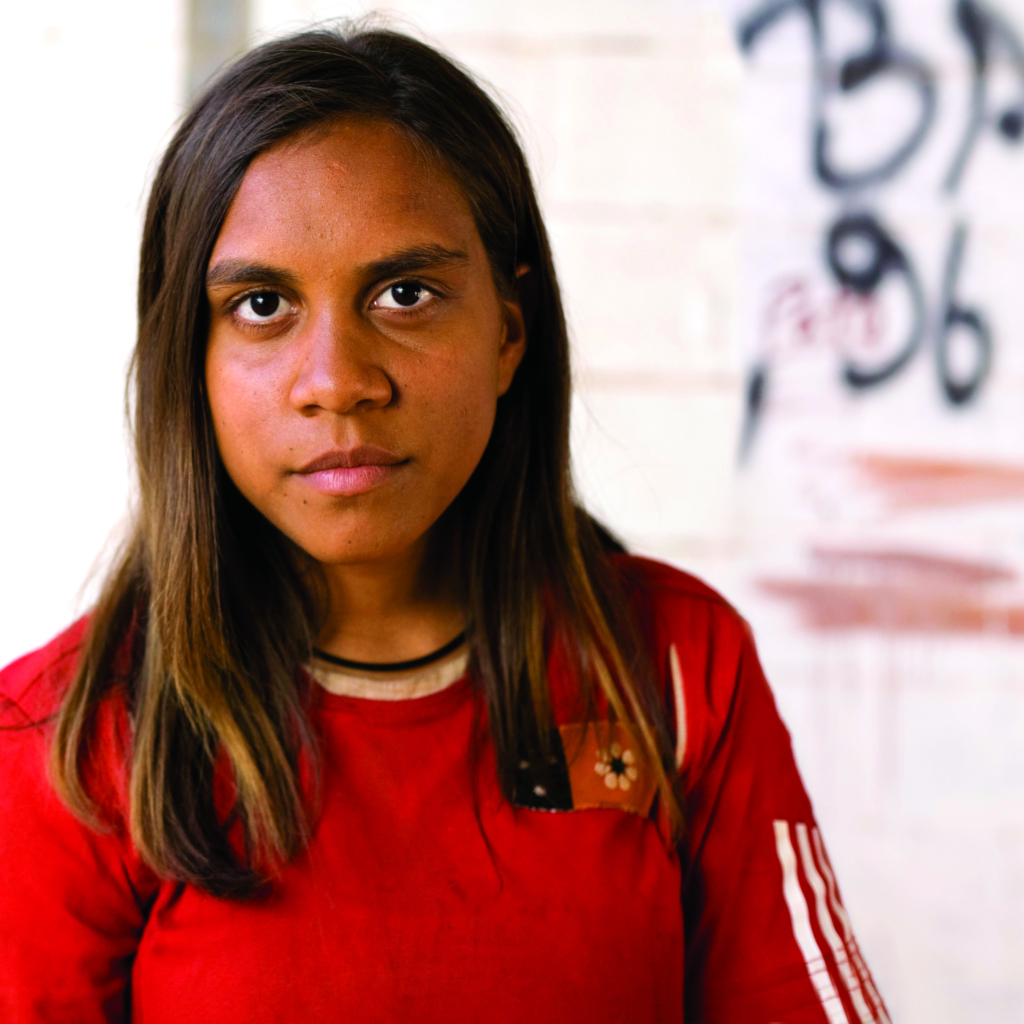
How did you prepare them for these roles?
WT: I didn’t really prepare with them at all. You know, I was looking for kids from communities because they would bring to the film their journey through their community, their last fourteen years growing up in a community. And I wanted that personal experience, rather than me pushing them in whatever direction.
KS: That’s not to say that they have experienced stuff that happens in the film. But they had knowledge of the world where the characters come from.
WT: And I purposely decided not to do a two-week workshop with them because I think …
[Shelper jumps in.]
KS: Because we only cast them one week before we started shooting!
WT: Well, yes, because we only cast them one week before the shoot. [Laughs.] But also, because filmmaking sounds like a really exciting idea but it’s actually an incredibly demanding and painful and annoying thing to do. And so if we had put these two kids through an intensive two-week workshop, asking them to pretend to be a tree or a carrot, then they would have been sick of the film before we had even shot the first frame. So the only preparation I did with them was just to break down their shyness, just a couple of little things to encourage them to perform in front of the crew and with each other, to look into each other’s eyes. And that was it, we just threw them into the first scene and said ‘go!’
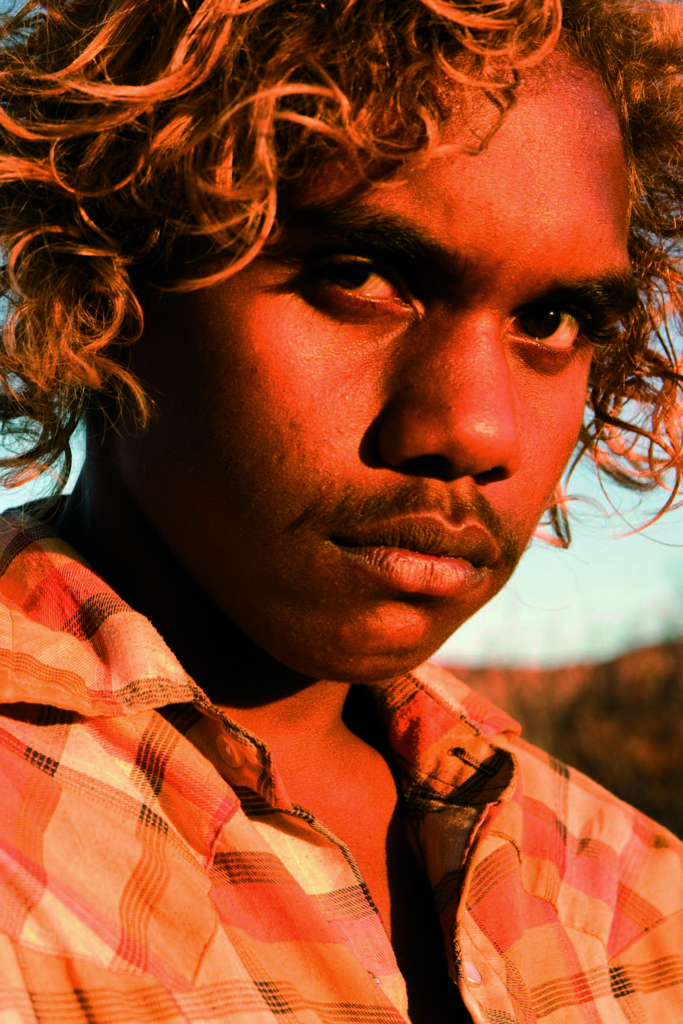
The film shows that you have a strong grasp of the possibilities of film style. Has your study of cinematography and your work as a DOP influenced your approach to writing and directing?
WT: Well, initially, the only reason I started writing was because as a DOP I was waiting around for people to give me jobs. And I was waiting more than I was working, and thinking to myself, ‘Wouldn’t it be great for someone to ring me and ask me to do this kind of film.’ And it wasn’t happening. And so, eventually, I thought, ‘Why don’t you start writing films that you would like to shoot, Warwick?’ So I started writing films that I would personally like to shoot. And these scripts started getting funded, and so I thought, ‘Maybe I should direct as well.’ And that’s where it all came from.
‘I like the idea of keeping the audience a step behind the character. So the audience is on the same journey as the characters in the film.’
– Warwick Thornton
But it’s also true that I went to film school and did three years of screen studies, sitting in cinemas watching seven-hour Russian classics and French classics and the occasional Spielberg film. I studied all that stuff. And while I don’t consciously put any of that into my script, it sort of comes out subliminally. I don’t want to rip off other people’s ideas. But there might be an emotion that came from the way they shot it. And I might want that emotion in my scene. So I design the scenes around that emotion, rather than around the specific shot sizes or track, or whatever.
One very apparent stylistic quality in Samson and Delilah is its sparseness. What is it, do you think, about a sparse narrative film that can make for such a compelling experience?
WT: The idea of sparse cinema to me is not, you know, a wide shot of a landscape with a small human figure dotted in it, and you hold that shot for three times longer than you should, etc. It has more to do with the idea of sparse storytelling. The classical formula is to feed and inject a story to the audience at certain places, to create turning points or introduce new characters so that the audience always knows everything that’s going on. The sparse idea of storytelling, on the other hand, is to never set up information away from the character … So, for instance, you don’t see the ominous black truck coming over the hill. You see it when it pulls up in front of the character. That’s the sparse idea that I like. There’s a thousand different tricks in cinema. And you can take things from all that stuff, from the great American cinema, the great French cinema. But a lot of that stuff is formulated in keeping the audience a step ahead of the character. I like the idea of keeping the audience a step behind the character. So the audience is on the same journey as the characters in the film.
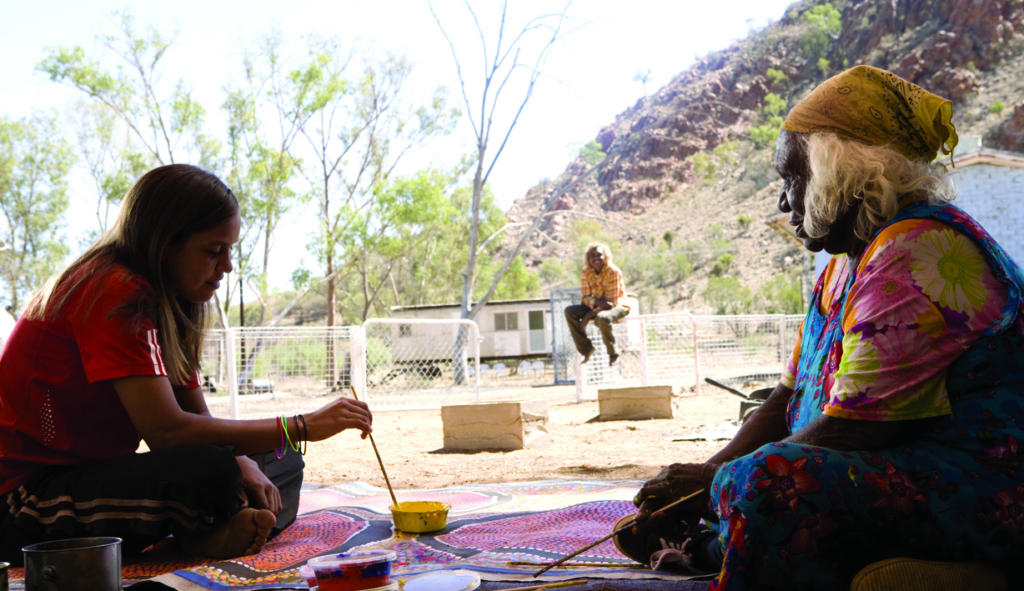
Samson and Delilah’s journey is radically removed from the day-to-day experiences of most city-dwelling Australians. The first thing you show Samson do, for example, is sit up in bed and inhale petrol fumes from an old tin can. Why did you choose to start your film in such a confronting, intense and painful way?
WT: That opening shot was designed right from the beginning. I’m a firm believer in sense of place and sense of style for an audience. At the beginning of a film the audience needs to know what kind of film they’re going to watch and where the bloody hell this film is set. And that’s what this shot is. ‘WE ARE NOT IN THE STATE OF KANSAS ANY MORE.’ This is a film that’s going to have issues, it’s going to have beauty and it’s going to be different. So that whole idea of not talking about problems like petrol sniffing … That’s what the opening shot is: ‘WE ARE GOING TO TALK ABOUT EVERYTHING.’
Delilah, despite her enormous challenges and problems, is far more contained than Samson. And it’s she who leads the process of healing in the last section of the film. Why, in your opinion, is Delilah the stronger half of the couple? And why is it the male in Australia who so often struggles more to cope emotionally with life?
WT: For me, personally, it wasn’t a decision to say ‘she is stronger than him’. That’s just the way it is. I grew up in a family where, you know, the males were absent and the females had to do everything. And so that’s how I see life. That’s how it works because that’s the way I grew up. Delilah is basically my homage to my sisters and my mother, and to all the wonderful women in the world who have looked after me. And I love the strength of Delilah. I’m a romantic, and I love the idea of the woman being stronger and pulling you out of the mess, and that makes your love for them even more powerful.
KS: And it’s the truth.
WT: There you go. From a chick. This bloke made a chick flick.
‘There are no answers. And all I can do is create questions. I don’t have a bloody answer for Samson and Delilah and I shouldn’t have. It’s serious.’
– Warwick Thornton
This film doesn’t strike me as being very interested in explaining the problems facing young Indigenous people today. It’s seems to be more interested in showing the problems experienced by two young Indigenous people.
WT: That’s incredibly important. There are no answers. And all I can do is create questions. I don’t have a bloody answer for Samson and Delilah and I shouldn’t have. It’s serious. All we can do is open up and create questions. So as far as the audience is concerned, they can answer their own questions in that sense. There’s a couple of little answers, maybe. But I don’t know what they are. And it’s a love story anyway, and love doesn’t work perfectly.
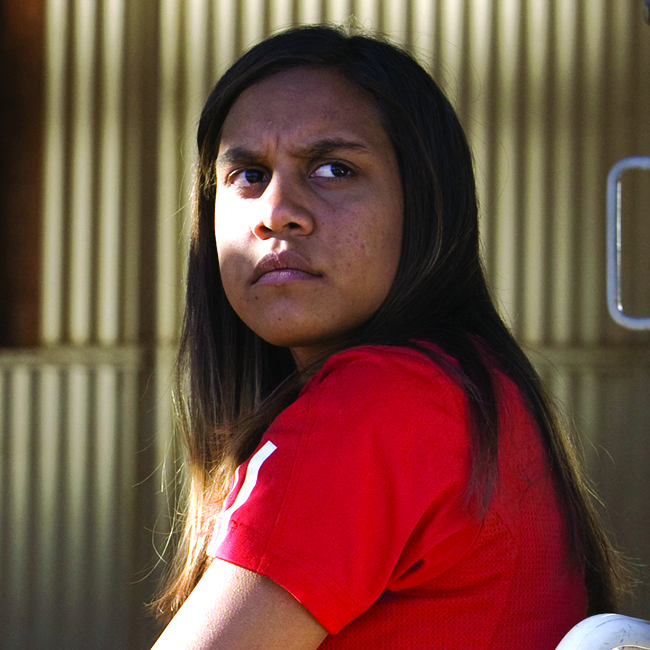
In creating questions you engage the audience in a process of trauma and resolution. At the end of your film there’s a sense that all this suffering has not been for nothing, at the very least. What, if anything, would you like audiences, and Australian audiences in particular, to take from this traumatic process?
WT: That love overcomes anything. And that these beautiful children of ours are really special. And they need help. And just some form of understanding from an audience is a great start.
I suspect you may come under fire from some who feel your treatment of white Australians in the film is too harsh, that the white characters are too passive in the face of Samson and Delilah’s suffering. How would you respond to the charge that your film presents a ‘black armband view’ of the present?
WT: Guilty!
[Shelper jumps in.]
KS: No, because the Aboriginal characters are just as unhelpful as the non-Indigenous characters, particularly in the community.
Nevertheless, the situation you present of black–white relations is pretty grim.
WT: It’s not a film about how bad white people are. People might say we’ve never seen this. But actually it’s right there in front of you, always. Two teenage kids trying to survive on the streets of anywhere. And the obstacles put in front of them, whether black or white, are still obstacles they’ve got to get through. Samson and Delilah never blame the whitefellas, or the blackfellas. They just see the obstacles in their way, for them to survive … It’s hard for me to respond to such things. This is a really personal film for me. Everything in this film I have seen growing up in Alice Springs and Santa Teresa, as well as during all the time I’ve spent in communities around Australia. I’ve seen some atrocious things and I’ve seen some of the most beautiful things! So it’s hard for me to dissect my own experience and my own film. It’s about this love of my kids and a story of how they have such a hard bloody time. And it’s about opening those doors for the rest of the world to see that … You have to be careful. People might need to hear about the next step in reconciliation. But is this the right film to do that? You have to be careful of what you bring and you need. Samson and Delilah is this beautiful journey of these two children, and it’s bloody hard. But this film isn’t the defining next step in reconciliation. And it’s dangerous for people to have to, or want to, need that.
KS: And it’s also a film in which these kids’ whole world is really difficult, including their world in the Indigenous community. What happens there is the reason why they leave the community. It’s a very harsh world, black or white.
WT: Yes. Aboriginal law and culture is a tough law and a tough culture. And for our kids, it’s not as if everything is going to be perfect because the traditional ‘way’ of Indigenous culture will fix everything. It’s bloody hard. Aboriginal law is a lot harder than whitefella law. And so for a fourteen-year-old kid who aspires to be P. Diddy, where does P. Diddy fit into Aboriginal law? Or Nike? You know, these kids want more, and everybody around them is saying ‘no, you’ve got to go back to your basics’. So it’s a really crazy situation for them.
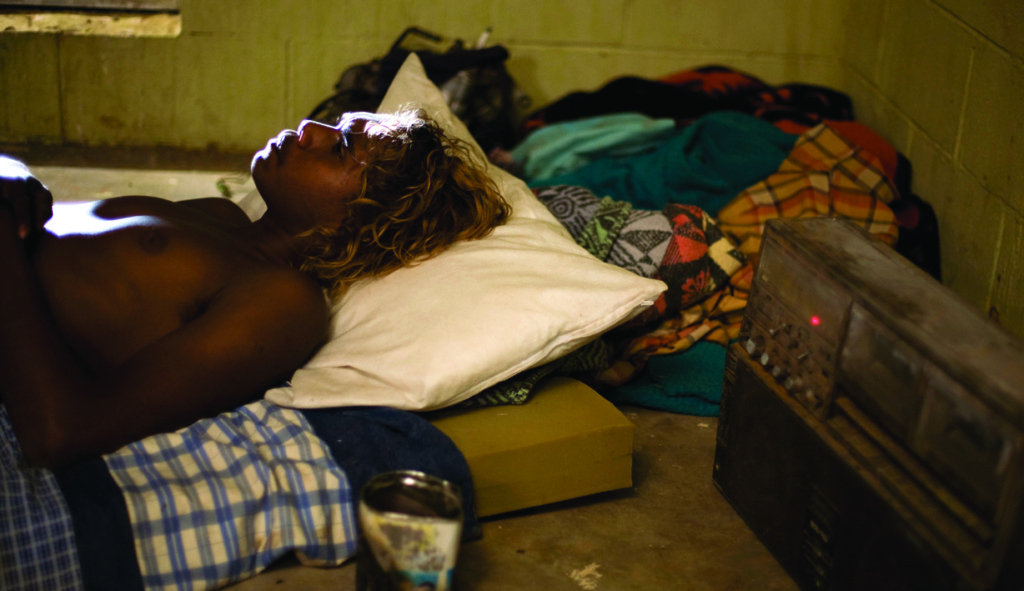
Despite your aversion to making definitive statements, this film will inevitably be cast into the role of spokesperson for Indigenous communities in Australia. Is this a role you have reflected on?
WT: Seriously. Listen. Two Aboriginal communities are 200 kilometres apart. OK? They are worlds apart. They are worlds apart in their language, what their needs are. This one might have a great health clinic. This one might have a great school. Do you know what I mean? If you want to help Aboriginal people in Central Australia to have a better life, you have to go to every single community. And every single one will have different needs. A lot of them might have shared needs. But the way in which they receive them might be completely different. That’s why there is no one answer. And I’ll be the first one to run a mile if anyone thinks that I should be a spokesman on any of that stuff. I can talk on behalf of my family. But I wouldn’t dare talk on behalf of anyone else’s family. And when we talk about Indigenous issues, we’re talking about family, brothers, sisters, cousins, the Aboriginal way. That was part of Johnny Howard’s problem. He found two key blackfellas in Australia and decided that they were the law and that they knew everything. And they don’t. And those people should have known better than to speak on behalf of everybody. Every community, every household has different needs. And that’s not just a black thing. That’s a white thing as well. You have two people living in a suburb next to each other. They both have different needs.
So, both of you, what is your highest hope for this film?
KS: That every person in Australia sees it.
WT: Yep.
And what of possible international screenings?
WT: All the international mob are getting interested. I think there is a hunger out there for indigenous film. I think the world is starting to realise that there’s this unique perspective, and it comes from all sorts of indigenous people from around the world. And it’s going to become this incredible cinema. And it’s starting to become this incredible cinema.
KS: But, primarily, we made this film for Australian audiences. And if as many Australians can see this film as possible, then that’s the most important thing to us. Samson and Delilah is a love story, a beautiful love story between two teenagers. It’s not a documentary. It’s not a report on Four Corners. It’s a dramatic film that’s designed to take you on a journey, and to take you to a place that you might not normally get to go in your day-to-day life, to feel completely involved in the life of the characters in the story. So that’s the number one objective: for people in Australia to go and see it and to be engaged and emotionally moved and to feel a real empathy with the characters in a way that most Australians don’t in everyday life. And that’s the job of cinema, to transport people to places where they would not normally be able to go.
